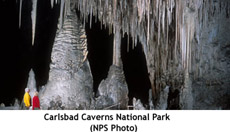After posting the other day about national park visitation, I talked to some folks, looked at some statistics, thought some more about the issue, and decided there's more to this topic to let the sun shine down upon.
For instance, while New Mexico's tourism secretary complained to the House Parks subcommittee about declining national park visitation, did he also mention that visitation to his own state park system has been relatively flat the past five years?
Also, in the wake of the hurricanes that battered Florida and the Gulf states and their national park units, the fact that the Paradise Inn in Mount Rainier National Park is closed for renovations, and last summer's high gas prices, is it any wonder that national park visits dipped?
Gulf Islands National Seashore alone saw 2005 visitation drop 2.5 million from the previous year, a staggering number that comprises 74.5 percent of the national park system's overall visitation decline from 2004 to 2005.
To be sure, trying to clearly identify what motivates folks to visit national parks, or to head elsewhere, is tough, if not impossible (although hurricanes are easy to identify as culprits). Why did overall National Park Service visitation drop 11.2 million from 2002 to 2003 and then rebound by nearly 11 million in 2004?
Yet at the same time, New Mexico's state park system is not exactly booming, either, despite the fact that 70 percent of the state's population lives within 40 miles of a state park. In 2001 the system counted 4 million visitors, a number that was repeated in 2002 before it slipped to 3.9 million in 2003 and 3.8 million in 2004. Last year was relatively strong, as visitation rebounded to 4.4 million.
While water levels in the state's reservoirs don't seem to have too great an impact on visitation, with a poor water year predicted this year New Mexico's state parks system is aggressively going after visitors by extending the maximum stay at parks from 14 days to 21 days; offering a package that gets you a free third night at a campground after you pay for the first two; marketing its $40 Annual Day Use pass that is fully transferable, and; offering star parties at select parks.
While last week's subcommittee hearing was filled with calls for the Park Service to do more marketing and whatever else needs to be done to increase visitation, it's a bit hard to understand the clamor when, in many parks, you need to call months ahead of your vacation to land a room in the location of your choice on the date of your choice.
I'm trying to rummage up occupancy rates at lodges at some of the better known parks, but the concessionaires are hesitant to release those numbers. The Park Service does track lodging visits, but not by specific property, so it's hard to tell how many lodges, if any, sell out on a regular basis during the high seasons. What the NPS numbers do show is that there has been a fall-off from 1992, when the parks enjoyed a record 4,118,057 lodging guests, and 2005, when there were 3,430,856.
But again, as I pointed out in yesterday's post, lodging numbers tend to rise and fall from year to year. Interestingly, while last year's lodging total was the lowest since 1983, campground visits in 2005 set a record, at 1,186,955. I also find it interesting that 1983's lodging total of 3,317,010 guests is just 113,856 visitors below 2005's figure, yet overall park visitation in 1983 was nearly 30 million less than in 2005.
In light of the rise in campground visits and the relative strength of lodging in 1983 versus 2005, could it be that some lodging properties are priced too high?
Without lodging occupancy numbers, it's hard to completely understand calls by folks such as John Schoppmann of Forever Resorts, which operates lodges in 17 national parks, for more visitation. If lodges already are near full or completely sold out, where will the concessionaires put the additional guests they want?


 Support Essential Coverage of Essential Places
Support Essential Coverage of Essential Places







Comments